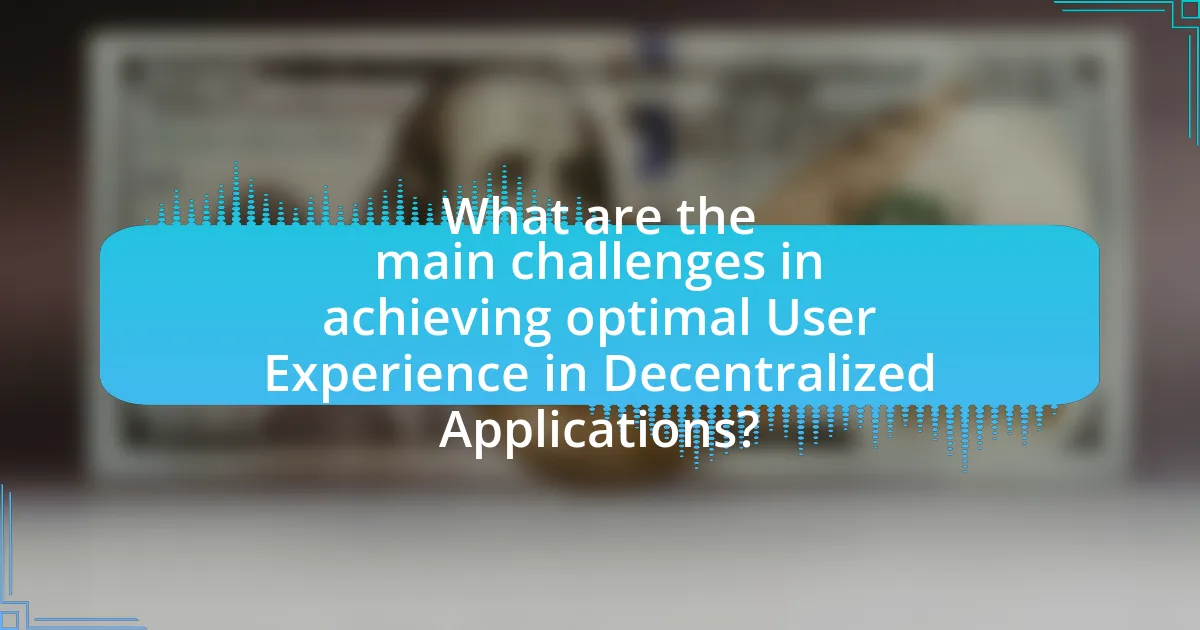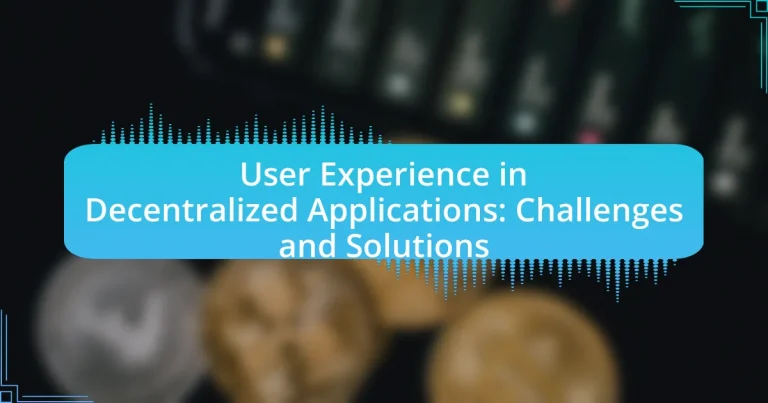User experience (UX) in decentralized applications (dApps) is crucial for user satisfaction and retention, yet it faces unique challenges such as complex interfaces, slower transaction speeds, and cumbersome onboarding processes. Research indicates that a significant percentage of users abandon dApps due to poor UX, emphasizing the need for intuitive design and seamless functionality. This article explores the differences in user expectations between dApps and traditional applications, the key characteristics impacting UX, and the main challenges in achieving optimal user experiences. Additionally, it discusses practical solutions, including improved design principles and educational resources, to enhance user engagement and foster the adoption of decentralized technologies.

What is User Experience in Decentralized Applications?
User experience in decentralized applications (dApps) refers to the overall satisfaction and usability that users experience while interacting with these applications. dApps often face unique challenges such as complex interfaces, slower transaction speeds, and a lack of user-friendly onboarding processes compared to traditional applications. Research indicates that 70% of users abandon dApps due to poor user experience, highlighting the importance of intuitive design and seamless functionality in enhancing user engagement and retention.
How does User Experience differ in Decentralized Applications compared to traditional applications?
User experience in decentralized applications (dApps) differs significantly from traditional applications primarily due to the complexity of blockchain technology and the lack of centralized control. In dApps, users often face challenges such as longer transaction times, the need for cryptocurrency wallets, and a steeper learning curve, which can lead to frustration and confusion. For instance, a study by the Ethereum Foundation highlights that 70% of users find the onboarding process for dApps cumbersome compared to traditional apps, which typically offer seamless user experiences. Additionally, the decentralized nature of dApps can result in inconsistent performance and user interfaces, further complicating user interactions.
What are the key characteristics of Decentralized Applications that impact User Experience?
Decentralized Applications (dApps) are characterized by their transparency, user control, and security, which significantly impact User Experience. Transparency allows users to verify transactions and operations on the blockchain, fostering trust. User control is enhanced as individuals maintain ownership of their data and assets, leading to a more personalized experience. Security is bolstered through cryptographic measures, reducing the risk of data breaches and enhancing user confidence. These characteristics collectively create a unique User Experience that differs from traditional applications, as users engage with a system that prioritizes autonomy and safety.
How do user expectations vary between Decentralized Applications and centralized platforms?
User expectations differ significantly between Decentralized Applications (dApps) and centralized platforms, primarily in terms of control, privacy, and reliability. Users of dApps expect greater control over their data and transactions, as these applications operate on blockchain technology, which emphasizes user sovereignty and transparency. In contrast, users of centralized platforms often prioritize ease of use and quick access to services, accepting a trade-off in control for convenience and speed.
For instance, a survey by ConsenSys in 2020 indicated that 73% of respondents valued privacy and data ownership as key benefits of dApps, while 62% of users on centralized platforms prioritized user-friendly interfaces and customer support. This highlights the fundamental difference in user expectations: dApp users seek autonomy and security, whereas centralized platform users often favor efficiency and support.
Why is User Experience critical for the adoption of Decentralized Applications?
User Experience is critical for the adoption of Decentralized Applications because it directly influences user engagement and retention. A positive user experience simplifies complex processes inherent in decentralized systems, making them more accessible to a broader audience. Research indicates that 88% of online consumers are less likely to return to a site after a bad experience, highlighting the importance of intuitive design and usability in driving user adoption. Furthermore, as decentralized applications often involve intricate interactions with blockchain technology, a seamless user interface can significantly reduce the learning curve, fostering greater trust and encouraging users to explore these applications further.
What role does User Experience play in user retention for Decentralized Applications?
User Experience (UX) plays a critical role in user retention for Decentralized Applications (dApps) by directly influencing user satisfaction and engagement. A well-designed UX enhances usability, making it easier for users to navigate complex functionalities inherent in dApps, which often involve blockchain technology. Research indicates that 88% of online users are less likely to return to a site after a bad experience, highlighting the importance of intuitive design and seamless interactions in retaining users. Furthermore, effective UX design can reduce the learning curve associated with dApps, fostering user confidence and encouraging continued use. Thus, prioritizing UX in dApp development is essential for maintaining a loyal user base.
How can poor User Experience hinder the growth of Decentralized Applications?
Poor user experience can significantly hinder the growth of decentralized applications (dApps) by deterring user adoption and engagement. When dApps are difficult to navigate, slow to respond, or lack intuitive design, potential users are likely to abandon them in favor of more user-friendly alternatives. Research indicates that 88% of online consumers are less likely to return to a site after a bad experience, highlighting the critical importance of user experience in retaining users. Furthermore, if users encounter frequent technical issues or complex processes, they may develop a negative perception of the entire decentralized ecosystem, limiting the overall market growth and innovation in this space.

What are the main challenges in achieving optimal User Experience in Decentralized Applications?
The main challenges in achieving optimal User Experience in Decentralized Applications include usability, scalability, and security. Usability issues arise from complex interfaces and the need for users to manage private keys, which can deter non-technical users. Scalability challenges stem from network congestion and slow transaction times, impacting responsiveness and user satisfaction. Security concerns, such as vulnerabilities in smart contracts and the risk of hacks, can undermine user trust and lead to negative experiences. These challenges are supported by studies indicating that user retention in decentralized platforms is significantly lower than in traditional applications, highlighting the need for improved user-centric design and functionality.
What technical barriers affect User Experience in Decentralized Applications?
Technical barriers that affect User Experience in Decentralized Applications include scalability issues, high transaction costs, and complex user interfaces. Scalability challenges arise because many decentralized networks struggle to handle a large number of transactions simultaneously, leading to slow processing times. High transaction costs can deter users, especially during peak network usage, as fees can become prohibitively expensive. Additionally, complex user interfaces often confuse users unfamiliar with blockchain technology, making it difficult for them to navigate and utilize the applications effectively. These barriers collectively hinder the overall user experience in decentralized applications.
How do network latency and transaction speed impact User Experience?
Network latency and transaction speed significantly impact User Experience by affecting the responsiveness and efficiency of decentralized applications. High network latency can lead to delays in data transmission, causing users to experience lag when interacting with the application. For instance, a study by Akamai Technologies found that a 100-millisecond delay in load time can reduce conversion rates by 7%. Similarly, slow transaction speeds can frustrate users, as they may have to wait longer for their actions to be processed, leading to dissatisfaction and potential abandonment of the application. Therefore, optimizing both network latency and transaction speed is crucial for enhancing User Experience in decentralized applications.
What security concerns arise that can affect User Experience?
Security concerns that can affect User Experience include data breaches, phishing attacks, and inadequate encryption. Data breaches can lead to unauthorized access to sensitive user information, resulting in loss of trust and potential financial harm. Phishing attacks exploit user vulnerabilities, often leading to compromised accounts and a negative perception of the application. Inadequate encryption can expose user data during transmission, making it susceptible to interception and misuse. According to a 2021 report by IBM, the average cost of a data breach is $4.24 million, highlighting the significant impact on user trust and experience.
What usability issues are commonly faced by users of Decentralized Applications?
Users of Decentralized Applications (dApps) commonly face usability issues such as complex user interfaces, lack of intuitive navigation, and difficulties in managing private keys. These challenges stem from the inherent complexity of blockchain technology and the need for users to understand concepts like wallets and transactions. Research indicates that 70% of users abandon dApps due to confusing interfaces and poor user experience, highlighting the critical need for improved design and user education in the decentralized ecosystem.
How does the complexity of blockchain technology affect User Experience?
The complexity of blockchain technology negatively affects User Experience by creating barriers to understanding and usability. Users often encounter intricate processes such as wallet management, transaction confirmations, and security protocols, which can lead to confusion and frustration. For instance, a study by the Cambridge Centre for Alternative Finance found that 40% of cryptocurrency users reported difficulties in managing their private keys, highlighting the challenges posed by complex security measures. Additionally, the need for users to understand concepts like gas fees and consensus mechanisms further complicates interactions with decentralized applications, resulting in a steep learning curve that can deter potential users.
What are the common navigation challenges users encounter in Decentralized Applications?
Users encounter several common navigation challenges in Decentralized Applications (dApps), including complex user interfaces, lack of standardization, and limited onboarding resources. Complex user interfaces often overwhelm users, making it difficult to navigate and utilize the features effectively. The lack of standardization across different dApps leads to confusion, as users must adapt to varying layouts and functionalities. Additionally, limited onboarding resources hinder new users from understanding how to interact with the application, resulting in a steep learning curve. These challenges can significantly impact user experience and adoption rates in the decentralized ecosystem.

What solutions can enhance User Experience in Decentralized Applications?
Solutions that can enhance User Experience in Decentralized Applications include improved user interfaces, seamless onboarding processes, and enhanced transaction speeds. Improved user interfaces simplify navigation and interaction, making it easier for users to engage with the application. Seamless onboarding processes, such as one-click wallet creation and intuitive tutorials, reduce barriers to entry, allowing new users to quickly understand and utilize the application. Enhanced transaction speeds, achieved through layer-2 solutions or optimized blockchain protocols, minimize waiting times and improve overall satisfaction. These enhancements are supported by user feedback indicating that streamlined experiences significantly increase user retention and engagement in decentralized platforms.
How can design principles improve User Experience in Decentralized Applications?
Design principles can significantly enhance User Experience in Decentralized Applications (dApps) by promoting usability, accessibility, and intuitive navigation. By applying principles such as consistency, feedback, and simplicity, developers can create interfaces that are easier for users to understand and interact with. For instance, consistent design elements help users predict how to navigate the application, while immediate feedback on actions reinforces user confidence. Research indicates that user-centered design approaches can lead to a 50% increase in user satisfaction and engagement in digital platforms, highlighting the importance of effective design in improving overall experience in dApps.
What are the best practices for creating user-friendly interfaces in Decentralized Applications?
The best practices for creating user-friendly interfaces in Decentralized Applications (dApps) include simplifying navigation, ensuring clear feedback, and prioritizing security. Simplifying navigation allows users to easily understand and interact with the application, which is crucial given the complexity often associated with blockchain technology. Clear feedback mechanisms, such as notifications for transaction confirmations, enhance user confidence and understanding of the application’s status. Prioritizing security involves implementing robust authentication methods and transparent data handling practices, which are essential in building trust among users. Research indicates that user-friendly design significantly increases user engagement and retention in dApps, highlighting the importance of these practices in fostering a positive user experience.
How can user feedback be effectively integrated into the design process?
User feedback can be effectively integrated into the design process by employing iterative design methodologies that prioritize user input at each stage. This approach involves collecting feedback through surveys, usability testing, and user interviews, which allows designers to understand user needs and preferences. For instance, a study by Nielsen Norman Group highlights that usability testing can reveal critical insights, leading to design improvements that enhance user satisfaction. By continuously refining the design based on real user experiences, teams can create more intuitive and user-friendly decentralized applications.
What role does education play in improving User Experience for Decentralized Applications?
Education plays a crucial role in improving User Experience (UX) for Decentralized Applications (dApps) by equipping users with the necessary knowledge to navigate complex interfaces and functionalities. When users understand the underlying principles of blockchain technology and the specific features of dApps, they are more likely to engage effectively and utilize the applications to their full potential. Research indicates that user education can significantly reduce the learning curve associated with dApps, leading to increased user satisfaction and retention rates. For instance, a study by the Blockchain Research Institute found that informed users are 60% more likely to adopt and regularly use dApps compared to those without adequate education. This highlights the importance of educational initiatives in fostering a positive UX in the decentralized ecosystem.
How can tutorials and onboarding processes enhance user understanding and engagement?
Tutorials and onboarding processes enhance user understanding and engagement by providing structured guidance that simplifies complex concepts. These processes break down information into manageable steps, allowing users to learn at their own pace. Research indicates that effective onboarding can increase user retention by up to 50%, as users feel more confident navigating the application. Furthermore, tutorials often incorporate interactive elements, which have been shown to boost engagement by 60% compared to passive learning methods. This combination of structured learning and interactivity fosters a deeper understanding of the application, ultimately leading to higher user satisfaction and continued usage.
What resources are available to educate users about Decentralized Applications?
Comprehensive resources available to educate users about Decentralized Applications (dApps) include online courses, documentation, and community forums. Online platforms like Coursera and Udemy offer courses specifically focused on blockchain technology and dApp development, providing structured learning paths. Official documentation from blockchain platforms such as Ethereum and Polkadot serves as a vital resource, detailing technical specifications and development guidelines. Additionally, community forums like Stack Exchange and Reddit facilitate discussions and knowledge sharing among users and developers, enhancing understanding through real-world experiences and problem-solving. These resources collectively empower users to grasp the complexities of dApps effectively.
What are some practical tips for optimizing User Experience in Decentralized Applications?
To optimize User Experience in Decentralized Applications, developers should focus on simplifying user interfaces, enhancing transaction speed, and providing clear onboarding processes. Simplified user interfaces reduce cognitive load, making it easier for users to navigate complex decentralized systems. Enhancing transaction speed is crucial, as delays can frustrate users; utilizing layer-2 solutions can significantly improve performance. Clear onboarding processes, including tutorials and tooltips, help users understand how to interact with the application effectively, which is essential given the complexity of decentralized technologies. These strategies collectively contribute to a more intuitive and efficient user experience in decentralized applications.

















